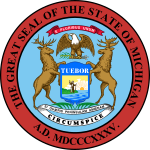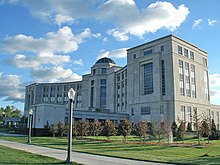Government of Michigan
Government of Michigan | |
|---|---|
 | |
| Part of | United States |
| Constitution | Constitution of Michigan |
| Legislative branch | |
| Name | Michigan Legislature |
| Type | Bicameral |
| Meeting place | Michigan State Capitol |
| Upper house | |
| Name | Senate |
| Presiding officer | Garlin Gilchrist,President |
| Lower house | |
| Name | House of Representatives |
| Presiding officer | Joe Tate,Speaker |
| Executive branch | |
| Head of Stateand Government | |
| Title | Governor |
| Currently | Gretchen Whitmer |
| Appointer | Election |
| Cabinet | |
| Leader | Governor |
| Deputy leader | Lieutenant Governor |
| Headquarters | Gretchen Whitmer |
| Judicial branch | |
| Name | Judiciary of Michigan |
| Courts | Courts of Michigan |
| Michigan Supreme Court | |
| Chief judge | Elizabeth T. Clement |
| Seat | Lansing |
Michiganhas a republican form of government with threebranches of government:theexecutive branchconsisting of thegovernor of Michiganand the other independently elected constitutional officers; thelegislative branchconsisting of theHouse of RepresentativesandSenate;and thejudicial branchconsisting of theone court of justice.The state also allows direct participation of the electorate byinitiative,referendum,recall,andratification.[1]
Legislative branch[edit]

TheMichigan Legislatureis thestate legislatureof theU.S. stateofMichigan.It is organized as abicameralinstitution consisting of theSenate,theupper house,and theHouse of Representatives,thelower house.Article IV of theMichigan Constitution,adopted in 1963, defines the role of the legislature and how it is to be constituted. Legislative acts are published in the officialActs of the Legislatureandcodifiedin theMichigan Compiled Laws.[2]The Michigan Legislature meets in theMichigan State CapitolinLansing, Michigan.Michigan is one of ten states to have a full-time legislature.[3][4]
- State Officers Compensation Commission
The state officers compensation commission, consisting of seven governor appointed members, exists to set salaries for the governor and other elected officials, unless a two-thirds majority in both legislative chambers turned it down.[5]
- Independent redistricting commission
The independent redistricting commission draws up legislative and congressional districts after each census. The 13 non-office holding members consisting of five independent members, four self-declared Democrats and four self-declared Republicans, would be selected randomly by the secretary of state from submitted applications.[6]
A Commission on legislative apportionment was written into the 1963 state constitution. However, the same state constitution provided for land weighting factors for state senatorial districts. Such weighting factors were found unconstitutional by the United States Supreme Court inReynolds v Sims(1964) for violating the Equal Protection Clause of the United States Constitution.[7]Because land weighting factors were interdependent and not severable from the commission on legislative apportionment, the commission was also invalidated by the Supreme Court's decision inReynolds v Sims(1964). This commission was transferred to the Department of State under the Executive Organization Act OF 1965.[8]The state legislature has apportioned districts after census until 2020 as the November 6, 2018 general election proposal 2 created a constitutional independent redistricting commission.[6]
Executive branch[edit]
Michigan's elected executive officers are:[1]
For elected single person executives, term limits of two terms were put into place in 1993.[1]Since 1966, the lieutenant governor is elected with the governor on the same ticket.[9]The lieutenant governor is the president of the Michigan Senate[1]and acts as the governor when the governor is unable to execute the office, including whenever the governor leaves the state. The governor is the principal executive officer with the power of veto, appointment, reorganize executive government, budget proposal and other powers.[1]

The two other elected constitutional executives of the state are thesecretary of stateandattorney general.Both are elected separately for four-year terms concurrently with the governor/lieutenant governor slate. The elected officeholders are second and third in the line of succession respectively and may act as governor during disabilities or absences from the state. The attorney general is the state's chief law enforcement officer, executive agencies legal counsel and leads the Department of the Attorney General. The secretary of state and its department handles automobile-related licensing, elections and record holding.[1]
Departments[edit]
The 1963 Constitution requires that all permanent agencies or commissions, except universities, be assigned to one of a maximum of 20 principal departments.[1]The principal departments are the Department of:[10][11]
- Agriculture and Rural Development
- Attorney General
- Civil Rights
- Corrections
- Education
- Environment, Great Lakes and, Energy
- Health and Human Services
- Insurance and Financial Services
- Licensing and Regulatory Affairs
- Military and Veterans Affairs
- Natural Resources
- State
- State Police
- Labor and Economic Opportunity
- Lifelong Education, Advancement, and Potential
- Technology, Management and Budget
- Transportation
- Treasury
Type 1 agencies are under the administration of the agency but operate independently of the principal department in carrying out its function and in most cases created by a type 1 transfer.[12]Regulations are published in theMichigan Register(MR) and codified in theMichigan Administrative Code(MAC or AC).[13][14][15]
Education[edit]
The state board of Education is a statewide elected board that head theMichigan Department of Educationwhich oversees all education except that of the state universities.[1]
Michigan's state universitiesare immune from control by the legislature, many aspects of the executive branch, and cities in which they are located; but they are not immune from the authority of the courts. Some degree of political control is exercised as the legislature approves appropriations for the schools. Furthermore, the governor appoints the board of control of most state universities with the advice and consent of the state Senate. Only the board members of theUniversity of Michigan,Michigan State University,andWayne State Universityare chosen in general elections.
Medical Marijuana[edit]
In Michigan, medical and recreational cannabis is regulated by the Michigan Cannabis Regulatory Agency, formerly called the Marijuana Regulatory Agency.[16]Initially, when the law was passed, the state ran a Bureau of Marijuana Regulation within the Department of Licensing and Regulatory Affairs.[17]
Judicial branch[edit]

The court system consists of theMichigan Supreme Court,theMichigan Court of Appealsas theintermediate appellate court,the circuit courts anddistrict courtsas the two primarytrial courts,and several administrative courts and specialized courts. The Supreme Court administers all the courts. The Michigan Supreme Court consists of seven members who are elected on non-partisan ballots for staggered eight-year terms, while state appellate court judges are elected to terms of six years and vacancies are filled by an appointment by the governor, and circuit court and district court judges are elected to terms of six years.
Local government[edit]

Michigan is largely divided in the same way as many otherU.S. states,but is distinct in its usage ofcharter townships.Michigan ranks 13th among the 50 states in terms of the number oflocal governmentalentities.
The state is divided into 83counties,and further divided into 1,240townships,276cities,and 257villages.Additionally, the state consists of 553 school districts, 57 intermediate school districts, 14 planning and development regions, and over 300 special districts and authorities.[18]
County government[edit]
Michigan hashome rulefor counties, meaning there is flexibility for the organization of county government and number of elected officials.[19]
Some common elected officials include:
- County Commissioners
- County Clerk
- County Treasurer
- Sheriff
- Prosecuting Attorney
- Register of Deeds
- Drain Commissioner
See also[edit]
References[edit]
- ^abcdefgh"Chapter 2: About State Government"(PDF).Michigan In Brief: 1998–99.Public Sector Consultants, Inc. 1999. Archived fromthe original(PDF)on October 25, 2004.RetrievedJuly 7,2013.
- ^Browne, William P.; VerBurg, Kenneth (1995).Michigan Politics and Government: Facing Change in a Complex State.Politics and Governments of the American States.University of Nebraska Press.p. 349.ISBN0-8032-6088-1.LCCN94-18928.
- ^"States with a full-time legislature".Ballotpedia.RetrievedJuly 7,2017.
- ^National Conference of State Legislatures."Full- and Part-Time Legislatures".National Conference of State Legislatures.RetrievedJuly 7,2017.
- ^Harrison, Wilma L. (ed.)."2: About State Government"(PDF).Michigan in Brief: 2002–03.Public Sector Consultants. p. 9.RetrievedJanuary 8,2019.
- ^abGibbons, Lauren (November 6, 2018)."Voters Not Politicians declares victory for Proposal 2".MLive Lansing.Mlive Media Group.RetrievedJanuary 8,2019.
- ^"Constitution of Michigan of 1963 Article IV Legislative Branch Section 2 & 6"(PDF).legislature.mi.gov.State of Michigan.RetrievedJanuary 8,2019.
- ^"Michigan Legislature - Section 16.132".legislature.mi.gov.State of Michigan.RetrievedJanuary 8,2019.
- ^Dunbar, Willis F.; May, George S. (1995).Michigan: A History of the Wolverine State(3rd ed.). Wm. B. Eerdmans Publishing. p. 585.ISBN0-8028-7055-4.LCCN95-13128.
- ^MCL16.104
- ^"Executive Branch".State of Michigan.
- ^"T".Glossary.Michigan State Budget Office.RetrievedJanuary 25,2013.
- ^Browne & VerBurg (1995),p. 349.
- ^Administrative Rules in Michigan: A Manual of Style and Procedures(PDF).Michigan Legislative Service Bureau.2003. pp. 6–8.
- ^Koscielniak, Kimberly (January 2002)."Finding Michigan Agency Materials"(PDF).Michigan Bar Journal.81(1).
- ^"Michigan consolidates cannabis, hemp regulatory bodies".Financial Regulation News.February 17, 2022.RetrievedMarch 8,2022.
- ^https:// michigan.gov/mra/-/media/Project/Websites/mra/Laws-Rules-Other-Resources/R_333101_to_R_333133_1_671719_7.pdf?rev=0cc914ae729243fe80800930a8fc2658&hash=FA0D16D4D11FE3AE49A99C606A19B493[bare URL PDF]
- ^"Michigan's System of Local Government"(PDF).Michigan Manual 2005-2006.pp. 715–718.RetrievedMay 15,2007.
- ^"Elected county executives and county home rule in Michigan: Part one".MSU Extension.RetrievedNovember 1,2020.




